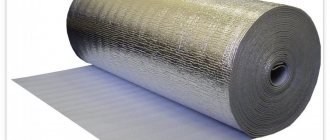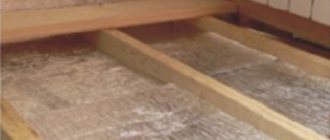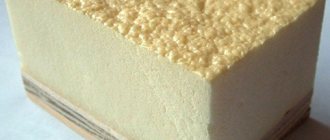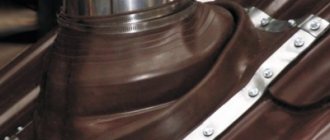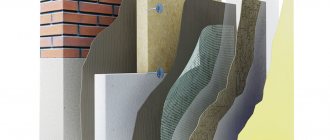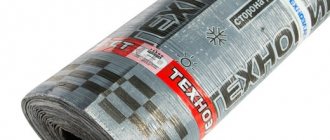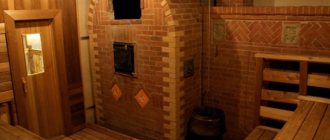Where is it used?
The widespread use of Isolon is due to its unique technical characteristics.
This material is actively used:
- during the repair and construction of houses, apartments and cottages as a universal insulation material with excellent moisture, noise and vapor protection;
- in the automotive industry as insulation and sound insulation, as well as car tuning;
- on ships and ships as insulation;
- in industrial engineering;
- as packaging material;
- as packaging and lining in the food industry;
- in the medical industry as a material for the manufacture of orthopedic products, for example, special insoles;
- in the footwear industry;
- in the oil and gas industry;
- in the leather and haberdashery industry as product parts, reflective elements of cooler bags and other temperature-preserving items;
- in the sports industry as an elastic base for mats, training boxing pads and other equipment;
- in sports, tourism and recreation as carpets and tatami;
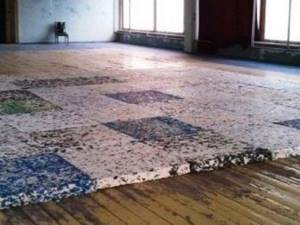
- in the production of toys such as hygienically clean puzzles, prefabricated construction toys, and so on;
- in needlework, for example, as a basis for making large flowers, voluminous decorative figures for celebrations and much more;
- in rocket science.

Izolon is so available in every hardware store that it will not be difficult to purchase it and use it at your discretion. Thanks to the wide range, this unique material can be used for almost any household, industrial, decorative, advertising and other purposes.
These are the main reasons why its popularity and scope of application are constantly expanding.
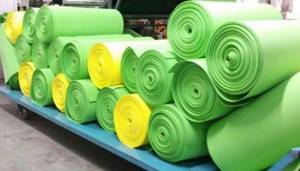
You will learn more about the areas of application of isolon by watching the following video.
What is isolon?
Izolon is a polyethylene foam whose structure consists of closed cells. This insulation is highly elastic and has excellent thermal insulation properties.
At the moment, it is one of the most effective materials for insulating various rooms. It has become widespread in areas such as mechanical engineering and the automotive industry. It is also used in the footwear industry, production of refrigeration and climate control equipment.
Composition of isolon and its characteristics
Izolon is made by foaming polyethylene, so its structure consists of many closed air pores in the synthetic material. The material is elastic, but very soft, so it can be laid on almost any geometrically complex surface. A special feature of the production of isolon is a thin foil layer of aluminum, thanks to which heat is reflected back into the room, and because of this, the main layer of insulation can be made much thinner than the usual 50-100 mm. Izolon has an initial thickness of 2 mm, and this parameter can increase to 100 mm, depending on the application. Thus, insulating a balcony with isolon will require a layer 20-30 mm thick, since the room is always located on the street. Foamed polyethylene is sold in rolls, sheets, strips or blocks.
According to the manufacturing method, isolon is of the following types:
- Foil-coated isolon NPE (the abbreviation stands for non-crosslinked polyethylene foam). It can be of different densities and thicknesses, with a regular and self-adhesive surface. Technology – method of extrusion and foaming with butane gas;
- Foil-coated isolon PPE (the abbreviation stands for cross-linked polyethylene foam). The technology for producing NPE material differs only in the use of another reagent - porofor, which makes it more environmentally friendly due to the absence of freon.
Structure and scheme of application of isolon Technical and operational parameters:
| Characteristic | Foaming ratio | ||||
| 30 | 20 | 15 | 10 | 5 | |
| Density, kg/m3 | 33 | 50 | 66 | 100 | 5 |
| Nominal thermal conductivity, W/m•K | 0,031 | 0,033 | 0,036 | 0,039 | 0,041 |
| Water absorption, cm3/m2 | 0,7 | 0,5 | 0,4 | 0,3 | 0,2 |
| Operating nominal temperature | -60°С + 100°С | ||||
| Sound absorption | at 250 Hz -7%, at 2000 Hz – 38%, at 6000 Hz – 60% | ||||
| Thermal energy reflection coefficient | from 95% to 97% | ||||
| Moisture permeability | < 1% | ||||
| Product thickness | from 2 mm to 100 mm |
Comparison of the characteristics of different insulation and building materials Isolon vapor barrier is divided into the following brands:
- Foil insulation PPE 500, 500-L - based on polyethylene cross-linked in a vertical oven with a bonded transversely directed structure;
- PPE 500 NR – based on polyethylene cross-linked in a horizontal oven with a bonded transverse structure;
- PPE 500-300 – polyethylene chemically cross-linked in a horizontal oven;
- 100, 100-L – non-cross-linked polyethylene with a molecular structure based on EPPE (extruded polyethylene foam).
Practical application of extruded polyethylene foam for home insulation Types of reinforced thermal insulation materials based on polyethylene foam:
- PPE with increased wettability characteristics, intended for painting and gluing;
- Izolon with increased rigidity properties;
- Insulation in a wide range of colors;
- Izolon with additives of fire retardants, as a result of which the degree of flammability of PPE is reduced.
Dimensions
To have a clear idea of what the material is, you should know what sizes the raw material can be.
The thickness of the products directly depends on the area of application of the isolon. To additionally insulate the floor, you can opt for products with a thickness of up to 5 mm; sound insulation of the roof should be done with sheets with a thickness of about 5-10 mm; interfloor ceilings require laying products with a thickness of 10-30 mm.
The size chart is very diverse: there are products with a thickness reaching up to 50 mm. Product lengths can range from 2 to 300 m; products with a length of 500 meters are not produced. The width of the isolon varies from half a meter to 2 m. Products in the form of slabs have the following dimensions - 1x1.11 m or 2x1.4 m.
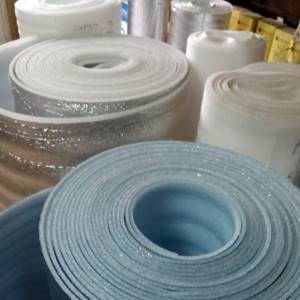
Features of the material

Before purchasing thermal insulation, you should take into account that the properties may differ between types. For example, if you have PPE in front of you, this indicates that the insulation is characterized by sound absorption at the level of 68%. Thickness can vary from 1 to 50 mm. Water absorption is no more than 1%. The reflection level reaches 97%.
It is also important to take into account the density; its maximum can be 200 kg/m3. The permissible temperature varies within the following limits: from -60 to +75 ˚С
The NPE variety has a different thickness, it reaches 16 mm, but the water absorption is less and equal to 0.2%. As for sound absorption, it is reduced and can vary from 3 to 13%. The density is also less and can be equal to a figure ranging from 19 to 35 kg/m³.
It is also important to consider the permissible temperature. In the case of NPE, the range is somewhat wider and varies from -80 to +80 ˚С
Izolon PPE, like its analogue, can be used for 90 years. Thermal insulation copes well with external factors, including precipitation and chemicals.
Among the main advantages are:
- high quality;
- UV resistance;
- environmental friendliness;
- minimum weight.
Due to the insignificant mass during the laying process, the foundation and walls do not suffer from loads.
Types of foil insulation
Industrial enterprises offer four main modifications of the material, based on the application area:
- Izolon A - one might say standard version, with a one-sided foil layer with a thickness of 3 to 10 mm.
- Izolon B is two-layer, that is, the foil is applied on both sides of foamed polypropylene, the structure is more durable, but accordingly more expensive.
- Izolon S is a foil self-adhesive isolon, which has a consistently high demand for vibration and noise insulation of cars. Insulating and soundproofing a car with isolon is considered a good way, especially in combination with various mastics. Working with such material does not require complex skills, and any adult man can do it.
- Izolon ALP isolon foil self-adhesive, additionally has a layer of polyethylene film up to 3 mm, this material becomes extremely durable, it can often be found when installing warm water floors.
Production Features
The special characteristics of the material require a complex, multi-stage and high-tech manufacturing process. It is common knowledge that there are a number of important processes involved during the production of a material. And all the stages can be briefly represented in three points:
- Mixing. At the same time, polyethylene, foaming agents and special substances that can affect the structure of polymers are mixed in a certain proportion.
- Extrusion. All substances are heated and melted, creating a special consistency.
- Foaming. Finished sheets of isolon, thanks to special substances, foam. At this stage, many pores form in the material.
When producing foil-coated isolon, at the very end of the technological process, thin aluminum foil is glued to a layer of foamed polyethylene using the lamination method.
General installation rules
In order for thermal insulation to be as effective as possible, you need to know how to properly apply and install insulation with foil. Primary requirements:
- Place the reflective surface towards the room. Failure to comply with the norm will negate the main advantage of foil insulation.
- Joining the panels closely - any gaps will lead to the appearance of cold bridges. Thin rolled materials can be laid with an overlap of 5-7 cm. The joint lines must be glued with foil tape.
- Aluminum is a good conductor of current. All wiring in contact with the insulation must be placed in corrugated plastic tubes.
- A gap must be provided between the finishing and the insulation. When installing insulation with double-sided foil, an air pocket is also left on the side of the outer wall.
- The use of self-adhesive insulation is permissible without additional fasteners. However, when finishing large vertical and inclined areas, it is better to pinpoint the material with staples.
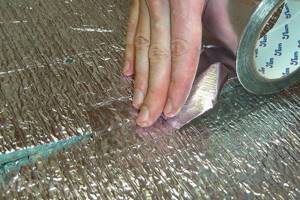
Installation technology
The surface of foil isolon is easily damaged, so it needs to be handled with care during transportation and installation. Depending on which part of the building or structure is to be insulated, the technology for laying the material is selected.
- If it is planned to insulate the house from the inside, then Isolon is laid between the wall and the finishing material, maintaining an air space between them to increase thermal efficiency.
- The best option for attaching the insulation would be to use wooden slats that form a small sheathing on the wall. Foil isolon is fixed to it using small nails. It is better to use a material that has a layer of foil on both sides (modification B). In order to prevent “cold bridges”, the joints are taped with aluminum tape.

- For thermal insulation of concrete floors, isolon is combined with another type of insulation. The latter is laid directly on the concrete, between the floor joists. Foil insulation is laid over this structure, and the floor covering is placed on it. Typically, this type of insulation is used as a substrate for laminate flooring. In addition to heat conservation, it helps reduce the load on the main floor and has a sound insulating effect.
- When insulating a balcony, it is better to resort to installing a multi-layer structure. The first layer in it is a one-sided foil-coated isolon, laid outward with a reflective layer. The next layer is insulation that can withstand increased mechanical loads, for example, polystyrene. Isolon is laid on top of it again. The installation technology repeats the principle of installing the first isolon layer. After the insulation is completed, they begin to install the sheathing on which the finishing materials are attached.
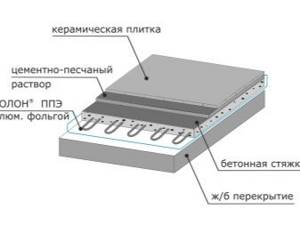
- The simplest way to insulate a living room in an apartment building without dismantling the walls is to place a layer of isolon behind the heating radiators. The material will reflect heat from the batteries, directing it into the room.
- For floor insulation, it is optimal to use ALP modification material. Type C material is used mainly for insulating buildings for technical and domestic purposes. For heat and sound insulation of car interiors, type C isolon is usually used, combining it with special mastics.

Advantages
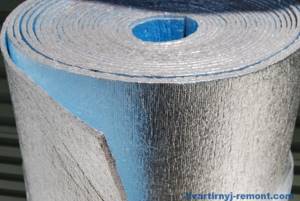
Advantages of isolon:
- Thermal insulation. Indispensable in the construction field.
- Steam and moisture protection. Allows use in wet objects such as baths (national types), swimming pools, Finnish saunas.
- Soundproofing isolon.
- UV resistance, which allows its use for external coatings;
- Fire safety.
- Light weight. Does not create additional load.
- Elasticity, which gives isolon its “flexible character”. It can easily take the shape of any object to which it is attached.
- Elasticity. Restores original shape. There is an opportunity to use it again.
- Rot resistant.
- Damping the force of blows.
- Easy installation.
- Safety for people. There are no releases of toxic materials.
- Environmentally friendly material.
- A thin layer of insulation does not reduce the internal dimensions of the insulated object.
The disadvantage of isolon is usually its cost. But if you consider that the service life is 90-100 years, then the investment in its purchase may not seem that big.
Soundproofing partitions: methods and materials
Scope of application of foamed thermal insulation
Due to its unique properties, isolon is widely used in many industries, construction and repair work. For example:
- Insulation of wall structures, floors, ceilings, floor slabs. Izolon has proven itself well in private and multi-storey construction, construction of garages, bathhouses, and outbuildings. Insulation of balconies and loggias without creating additional load on supporting structures.
- Vapor barrier for rooms with high humidity.
- Insulation of pipelines.
- Reliable insulation when installing self-leveling floors.
- Industry: packaging of medical equipment, production of thermal blankets, production of refrigeration chambers. It should be noted that life jackets are made on the basis of isolon, which help retain body heat during prolonged exposure to cold water.
- Protection of car elements from corrosion, additional body insulation.
It should be noted that no building material in the world has such versatility.
Application
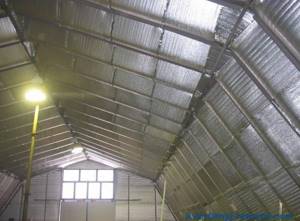
What is isolon is known in many areas, but primarily in the construction industry. The scope of use is determined by its main properties:
- thermal insulation;
- soundproofing;
- waterproofing.
The main area of application is construction:
- insulation of floors, walls, ceilings, roofs in permanent and country houses, basements;
- insulation and waterproofing of garages and inspection pits;
- insulation and soundproofing of closed balconies;
- insulation of production premises, workshops;
- sound insulation and insulation of gyms, offices;
- waterproofing of baths and saunas.
Isolon insulation is used in construction both indoors and outdoors.
Basic techniques for creating flowers from isolon
In order to make a flower from isolon, you need to clearly imagine the original and know thoroughly what each vein in the petal and sepal looks like
In addition, it is important to choose the right shade combination and sizes. After this you can start making templates

Photo zone with flowers from isolon PHOTO: pinterest.nz
What you need for work
A big plus for those who are just starting to master working with isolon: the material does not require the purchase of complex, expensive tools. It is very similar to foamiran, and every home has all the equipment to work with it:
- tailor's scissors, they can be replaced with a mounting knife;
- hair dryer, suitable not only for construction, but also for household use, but with two heating modes;
- glue gun, which must have a temperature switching mode;
- stapler, staples and threads;
- paints: in a spray can or acrylic.
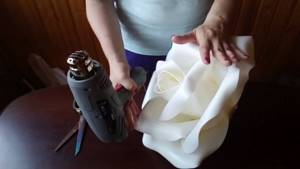
Using a hairdryer, you can give the blanks any shape PHOTO: ytube.tv
How to make a flower
Isolon is often used to make flowers of various sizes: from a tiny bud to a full-blown inflorescence or a composition the size of a person. They can be located on stems, formed into bouquets, and flowers are often used to create three-dimensional panels.
When creating flowers from isolon, it is necessary to take into account some nuances:
- Each flower or bud is assembled from several elements. Small parts are made in sizes 10x10, 12x12 cm², larger ones - from 20x20 to 50x50 cm². When assembled, the diameter of the flower can exceed 1 m;
- The thickness of the isolon is selected depending on the parameters of the flower. For small products you can use material with a thickness of 2 mm, for larger ones - over 3 mm.
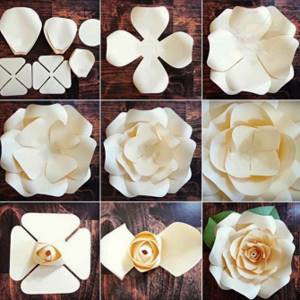
Assembling a flower PHOTO: pinterest.ru
Stem
For large growth flowers, the stem must first of all be strong and solid. A pipe made of metal, plastic or metal-plastic is best suited. Plastic elements can be given any bend by heating.
For buds or small flowers you can use the following material:
- wire, it is better to choose it with ready-made green insulation;
- thin metal rod;
- plastic cocktail straw.

For a small stem, ordinary wire is suitable PHOTO: livemaster.ru
Petals
The technique for forming the petals of different flowers is different; when making your own, use the following recommendations.
| Illustration | Flower | Flower formation technique |
| PHOTO: youtube.com | Rose | First, a bud is formed, half-opened and opened petals are placed around it |
| PHOTO: youtube.com | Peony | For a peony, a half-open bud is used; the petals have a carved edge at the top. |
| PHOTO: skillofking.com | Tulip | The flower consists of four petals, connected in pairs around a stem |
| PHOTO: pinterest.ca | Chrysanthemum | For a chrysanthemum you need to prepare a large number of thin petals that are connected around the stem |
Stand
Most often, the following options are used as a stand:
- welded structure made of steel base;
- a concrete stand, this option is similar to a welded structure, with the exception of the base, which is filled with mortar;
- a stand from different containers, into which cement mortar is poured, and before it hardens, part of the rods from the flowers is inserted.

Metal stands PHOTO: salvabrani.com
Use for insulation

Correct use of isolon - what is it for insulation? When constructing various structures, it is necessary to consider the issues of insulation and sound insulation.
You can insulate your home not only during construction, but also as a renovation to create comfort.
A subtlety that increases the efficiency of such work is the air cushion between the surface and the insulating coating:
- Wooden planks are fixed to a wall or other surface with a distance between them of no more than 90 cm.
- Install isolon. Fastening must be done sequentially, starting from the top bar. Having stretched the insulation, attach it to the next plank.
- Glue or fasten the joints using any of the technologies used.
If you plan to stick wallpaper over isolon insulation for aesthetic reasons, then you should select thin wallpaper that does not have much weight. Otherwise, the integrity of the isolon may be compromised. Primer is not acceptable.
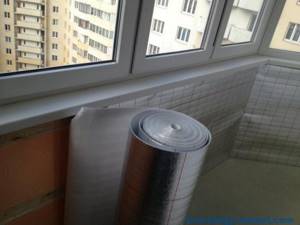
One common application is insulating a balcony. Will create the opportunity to use this space in colder times.
Construction professionals recommend that when insulating balconies, install according to the “sandwich” principle:
- the first layer is isolon with the foil facing out;
- the second layer is ordinary isolon or polystyrene foam. There are many myths about polystyrene foam;
- the third layer is again one-sided isolon with foil inside the balcony space.
After this, the sheathing is done and finishing work is carried out.

When insulating a living room, you should not forget to place the insulating material behind the central heating radiator. By the way, do you know which batteries are best to use in an apartment?
This is somewhat more difficult than laying on a free surface, but has an even more significant effect, increasing heat transfer from the heat source. The foil should be directed towards the room.
Basic properties
Many consumers are wondering what isolon is. If you are also one of them, you should know that the material does not perceive temperature changes and does not change parameters when they fluctuate sharply. The structure is characterized by high noise insulation qualities, while the thickness is relatively small.
Izolon is quite often used by motorists for interior decoration. It is impervious to moisture and is able to protect metal from corrosion. For the hood, you should purchase a foil version that is laid on mastic. In order to avoid installation difficulties, it is better to purchase insulation with an adhesive surface; it can even be laid on a base with complex geometry.
If you are wondering what isolon is, then you should also know that this material is durable and reliable. It does not require additional maintenance during operation, is fireproof, does not support combustion, but evaporates. At the same time, it decomposes into carbon dioxide and water.
The main purpose is repair work inside buildings. When creating self-leveling floors, a thin layer of thermal insulation is laid to prevent the solution from leaking to the lower floors. The layer acts as thermal protection and a water barrier, which is important when renovating multi-story buildings.
Among the main properties, ease of installation should be highlighted. The canvas will need to be laid out and secured. In the case of walls, ventilation must be provided. When insulation is carried out from the inside, in the absence of an air layer, the materials will collapse. This is due to the fact that they are hygroscopic and should be protected from moisture or provided with drying and ventilation.
When answering your question about what isolon is, you should know that it can also be used externally. This is due to the fact that the material is resistant to ultraviolet radiation. Due to the fact that isolon has high sound insulation properties, it can be used as insulation for a balcony; it will not decompose under the influence of ultraviolet radiation and will not attract insects, rodents and birds.
Possible uses of NPE
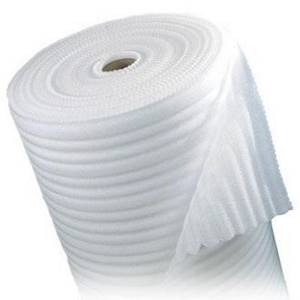
Thanks to its characteristics and properties, lack of toxicity, and low cost of production, this type of isolon has become indispensable for packaging. Having supplanted corrugated cardboard and bubble film, NPE gradually won and confidently holds 90% of the packaging materials market. Comfortable material does not deteriorate and absorbs shock and mechanical loads. And even the possibility of rupture due to a point load or contact with a sharp object is not a significant factor limiting its use. NPE packaging is used for food, dishes, glass products, furniture, any electronic, computer, household appliances, and other products. Isolon is convenient for transportation as gaskets and wrapping material.
In mechanical engineering, during repair and construction work, the use of NPE is limited. However, in the absence of high temperatures, significant load-bearing loads and a decrease in other quality requirements, “non-crosslinked” isolon is used as thermal insulation, protection from noise, steam, and condensate. NPE is often used as a substrate for leveling the surface before laying laminate or parquet or as energy-reducing reflective insulation (foil version).
Comparison of properties
To understand the difference between these materials, it is necessary to take a closer look at all their differences.
Properties of foamiran
Since the basis of this material is foamed rubber, as a result of its manufacture it turns out to be very light and flexible. That is, foamiran can not only stretch well, but also take any shape. In addition, it is worth noting that the form that this material takes is immediately preserved. Sheets of foamiran can be cut without much difficulty into the parts necessary for the master. Another very important point is that this material has water-repellent properties. Therefore, the finished product can be washed in case of contamination without worrying about the consequences.
It should also be noted that the material is environmentally friendly.
Since foamiran sheets have a porous structure, they lend themselves perfectly to painting. Most often, oil or acrylic paints are used for painting. In some cases, experienced needlewomen even use cosmetic shadows or crayons for this. To prevent the coating from wearing off in the future, it can be secured on top with varnish: either glossy or matte.
Despite the large number of advantages, there are also some disadvantages of this material. First of all, the price is too high, as well as the susceptibility to deformation. In addition, if the material is not used correctly, it will be easy to tear.
Properties of isolon
To begin with, it is worth considering the positive aspects of this material. First of all, isolon is a fairly dense and durable material, so it will be difficult to tear. You can cut isolon not only with scissors, but also with a cutter. Just like foamiran, isolon is hypoallergenic, lightweight, and melts quickly. This material is not afraid of moisture, is not susceptible to mold and is perfectly fixed.
When making flowers, pastels are most often used for coloring, which gives them a similarity to real flowers. However, painting can be done with acrylic paints and other dyes. Izolon does not emit toxins at all and does not have an unpleasant chemical odor.
However, this material also has some disadvantages, which differ in many ways from foamiran. First of all, it may be damaged during transportation. In addition, isolon quickly becomes covered with dust and can also quickly become electrified. For this reason, it is best to store it in a plastic bag, and finished products should be coated with a solution specially made for this purpose.
Polyethylene foam insulation Izolon PPE

Manufacturers produce it in various densities and thicknesses in the form of tapes, sheets, and rolls. With the application of a special layer of glue, self-adhesive foil isolon is extremely convenient to use. Non-self-adhesive isolon can be purchased, usually in rolls. To understand the advantages of folgoizolone and find out its basic properties, you must first remember what kind of material it is. Then it will be possible to understand all its nuances and specifics of operation. Judging by the term “folgoizolon”, we can say that this is the same isolon that has a metallized layer - ordinary foil.
This material is made from foamed polypropylene or polyethylene raw materials. For this reason, there are two modifications of this insulation on the market, bearing the abbreviated names NPE and PPE. However, their main indicators are practically the same, so we will not consider these products separately, but will talk about insulation in general terms.
Kinds
The following types are available:
- uncrosslinked – NPE;
- cross-linked – PPE, which is divided into subtypes: chemically cross-linked PPE NX and physically cross-linked PPE NR.
In terms of its characteristics, isolon NPE is inferior to cross-linked ones.
Izolon PPE is resistant to aggressive influences and has higher heat, sound and moisture insulation values. It is possible to combine different types in one product.
To reduce losses from radiation of heat waves absorbed by the internal surfaces of the room, a fairly simple but very effective method is used - covering the isolon with foil. The role of foil is its ability to reflect infrared rays. This significantly increases the importance of isolon in its fight against heat loss.
Please note: Mineral wool characteristics and properties
Foil-coated isolon comes in the following modifications:
- “A” – one-sided foil coating;
- “B” – coated on both sides at once, which increases resistance to external influences;
- “C” – self-adhesive;
- “ALP” – self-adhesive, with a protective film.
Insulation with foil must be laid in such a way that its metallized layer “looks” into the insulated room
When laying foil-coated isolon with a protective film, it should be carefully removed, freeing the surface with the applied adhesive composition. If a non-self-adhesive option is used, then you should use glue that is suitable for this purpose in terms of its properties.
Some varieties of isolon have a high wettability value, which facilitates the use of glue for their fastening.
Types of isolon
There are two types of isolon: cross-linked and uncross-linked. Uncrosslinked is a simple isolon that has not been subjected to any additional processing. Cross-linked is an isolon whose molecular structure has been changed and improved. You can even distinguish these two types visually: the cross-linked one has much smaller pores than the uncross-linked one. In addition to their appearance, their characteristics also differ. Cross-linked isolon has an increased service life and greater elasticity compared to non-cross-linked isolon. Depending on the type of manufacture, the material can be either in the form of thin sheets or in the form of thicker slabs.
Insulation and thermal insulation of floors on wooden beams
Such floors are installed above a ventilated basement or crawl space using wooden beams that are mounted in such a way that the load-bearing beams rest on the basement walls. Izolon insulation is installed directly under the beams as waterproofing. In such structures, Izolon acts not only as a waterproofing and insulation material, but also as a sound insulator. It protects against the most common impact noise, which, when propagated in building structures, usually causes great discomfort. The use of this material helps mitigate noise and prevents its spread.
Sound insulation Izolon. Application for wooden floors above a ventilated underground
Such ceilings are wood logs laid on brick pillars, on top of which the ceiling is laid. To provide heat and vapor barrier, the floor is laid using Izolon. This material, in turn, protects the wood from moisture vapor and rotting,
and also prevents cold air from entering the apartment from the underground. In addition, the material also acts as an insulator against impact noise, preventing its occurrence and spread. For thermal insulation and noise protection, it is recommended to use the same Isolon brands as for insulating concrete floors.
Thermal insulation Izolon for wooden floors built on the ground
When installing a wooden floor directly on the ground, it is important to remember the need to protect the wood not only from moisture vapor, but also from its capillary suction from the ground. Isolon, which has almost zero moisture absorption, is perfect for this purpose.
More details
Advantages and disadvantages
There are many advantages of this thermal insulation material:
- Low thermal conductivity coefficient;
- High thermal insulation characteristics;
- Isolon protects well from steam and moisture;
- Thanks to the closed cells, this material has a high degree of waterproofing;
- Although the protective layer of isolon is small, it has high shock and sound protection;
- The big advantage is the light weight of the material and elasticity;
- The material also has high dynamic strength;
- Due to its high chemical activity, this material is not used in some areas;
- Izolon resists gasoline, oil and other chemical compounds well. And also does not react with flammable substances;
- The service life of such thermal insulation material can reach 100 years. This is a big advantage of isolon. And also such material can be reused;
- Izolon is an environmentally friendly and safe material that does not pose any harm to human health and life.
There are several disadvantages of isolon:
- High cost of material;
- During transportation, isolon can be damaged;
- Thermal insulation using isolon must be carried out according to technology. If this is not done, damage to the structure may occur and, therefore, the material will not perform its function;
- It is necessary to adhere to the rules for storing izolon.
Despite the minor shortcomings of isolon, it meets many modern requirements and is a high-quality material for thermal insulation.
Properties and characteristics depending on the type
The properties and characteristics of isolon directly depend on its type and determine the possible scope of application. Before choosing a particular variety, it is worth getting acquainted with the available options.
Cross-linked – PPE
During production, changes occur in components at the molecular level. This group includes products with a cross-ligament and mesh molecular base. The specificity of the composition increases the resistance of the material to aggressive environments, and also increases moisture resistance.
Unstitched – NPE
This variety is distinguished by the almost complete absence of connections between the molecules of the components. Essentially, this is a gas-filled raw material with a closed cell structure. Even at the foaming stage during the heat treatment of the substance, carbon dioxide is added to it. It fills pores that are larger than other materials. In addition, NPE has less flexibility.
Based on the crosslinking method, it is possible to select materials with a chemical or physical option for performing this task.
Taking into account the structure, isolon can be foil or uncoated
PPE and NPE
PPE – cross-linked polyethylene foam. During the production of this variety, the components change their state at the molecular level. They come with a cross-ligamentous and mesh molecular base. Thanks to this, the material better resists the effects of aggressive substances and has increased moisture resistance, which significantly expands its possible scope of use.
PHOTO: elektro.guruThe cross-linked structure increases resistance to external influences
NPE – non-crosslinked polyethylene foam. This material has virtually no bonds at the molecular level. It is a substance with a closed cell structure filled with gas. During the production process, at the foaming stage during heat treatment of the feedstock, the mass is filled with carbon dioxide. Penetrating into the large pores characteristic of this variety, it gives the canvas the required properties.
Foil coated on one or both sides
In its structure and composition, this variety is no different from the classic one. However, it has a foil film with a thickness of 10 - 100 microns on one or both sides. For its manufacture, aluminum or another metallized composition can be used.
Due to its high performance characteristics, foil material is used when performing work inside and outside the building. The choice of variety depends on the scope of application. So, for installing floor coverings, Isolon with a heat-reflecting film is selected. During installation, the sheet is positioned so that it is on top.
Products without coating
The performance characteristics of this variety are relatively low. The absence of additional coating worsens its properties and reduces its cost. Due to its availability, it is used in various fields.
Covering and self-adhesive material
The covering material allows you to form an airtight coating. It is glued to the base with glue. The sheets are laid end-to-end or overlapped if the thickness is relatively small. The tightness of the connections is ensured using construction tape.
Self-adhesive isolon is attached to the base immediately after the protective film is removed. A special adhesive composition applied to the surface of the material will allow it to be fixed in the desired position. Self-adhesive foil isolon is especially popular.
Disadvantages and application features
- Expensive material;
- Requires careful transportation and can easily tear;
- Izolon cannot be plastered; it can simply tear.
Compliance with simple installation and operation measures will help the material maintain its remarkable characteristics.
- Isolon insulation is glued end-to-end; aluminum tape is used to seal the seams;
- To avoid the formation of condensation, it is necessary to leave space between the insulation and other building structures;
- It should be remembered that aluminum is a conductive material; you should be careful when installing foil insulation near electrical networks.
– The innovative material of the 21st century, foil-coated isolon, has long become an integral part in the installation of noise, heat and moisture insulation, both in domestic use and at industrial facilities. Izolon will fulfill its purpose with a small thickness, and correct installation will provide long-term operation. It remains to add that the manufacturer of the material, izolon, has passed multiple tests to meet high standards of quality, fire safety and environmental safety.
Installation technology
The main feature of the product is to ensure tightness, so all joints between products should be sealed. The working surface must be dry and free of various contaminants.
Experts say that one layer of 3-5 mm will be enough to provide high-quality insulation for the room. But the coldest places need to be insulated in several layers, or purchase a material with greater thickness and combine insulation with glass wool, forming a thermal insulation sandwich.

Thermal insulation of the subfloor includes the necessary list of works.
- After purchasing a material of appropriate thickness, the first step is to prepare the surface. If there is an old coating on it, it is dismantled and the floor is leveled.
- If necessary, products are cut to the required length and width; for this you need to take measurements of the working base. It is best to cut products with an ordinary knife.
- If self-adhesive material is used, then before installing it, the protective film is removed, and then the raw materials are laid. During work, the products must be lightly pressed against the surface to ensure better fixation.
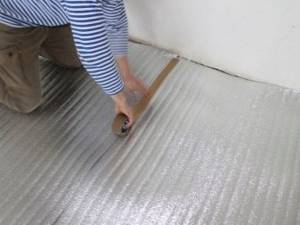
- Work with conventional products is carried out using acrylic adhesive compounds.
- Following the instructions for laying isolon on the base of the floor, before installing the raw materials, you need to apply waterproofing. However, in most cases, the flooring is not provided with additional protection from moisture.
- A polyethylene film is laid on top of the thermal insulation, since isolon does not absorb moisture.
- The material is fixed at the seams with tape, a construction stapler, or the products are welded to each other;
Related Posts
- Large flowers from isolon
- Underlay for insulation on the ceiling
- Polyethylene: properties and applications
- Which is better: polystyrene foam or polystyrene foam?
- How to glue fiberglass correctly?
- Fum tape technical characteristics, how and how much to wind on the thread
- Choosing non-flammable insulation for walls and ceilings: tips and tricks
- Isover thermal insulation overview
- Insulating a balcony with panoramic glazing: useful to know
- How to cut metal using a grinder
- Density of wet sand: properties and melting point of river sand
- 8 tips on how to choose crushed stone: types, fractions, brand, application
- How to dilute alabaster
- Alabaster: what is it? how to divorce? where to apply?
- Why line the roof and ceiling with clapboard and how to do it correctly? nuances of the procedure
- Penoplex or technoplex: which is better to choose and how do they differ?
- 9 types of heat-resistant tiles for fireplaces and stoves: choosing the best
- DIY foam cutting
- How to update old tiles in the bathroom
- How to properly glue fiberglass to drywall with your own hands
- Clinker tiles for facades: a universal facing material
- Insulating the attic from the inside if the roof is already covered: step-by-step instructions
- How to glue foam together
- What is the difference between aerated concrete and foam concrete?
- Foil insulation: types, properties and possibilities of use
Read with this
- Large flowers from isolon
- Underlay for insulation on the ceiling
- Polyethylene: properties and applications
- Which is better: polystyrene foam or polystyrene foam?
- How to glue fiberglass correctly?
- Fum tape technical characteristics, how and how much to wind on the thread
- Choosing non-flammable insulation for walls and ceilings: tips and tricks
- Isover thermal insulation overview
- Insulating a balcony with panoramic glazing: useful to know
- How to cut metal using a grinder
Insulation of the first floor floor
To carry out this type of work, inexpensive expanded clay is required. In terms of its qualities, it is not inferior to expensive insulation materials. Expanded clay is made from clay compounds and is environmentally friendly. 100 mm of expanded clay layer has the same characteristics as 1 m of brickwork and 250 mm of boards.
The use of other materials for insulating a wooden floor on the first floor imposes restrictions on the use of silicate, polymer and wood-shaving insulation. Unlike expanded clay, these materials are susceptible to destruction by rodents and accumulate moisture. Therefore, expanded clay looks much better against their background.
Expanded clay must be laid on a previously laid layer of waterproofing. Polyethylene film can act as a waterproofing material; the thicker the better. After laying, the edges of the film should protrude 10 cm above the joists along the perimeter of the walls. The technology of expanded clay insulation is simple, but quite labor-intensive.
Before pouring expanded clay, it is necessary to prepare a mixture of different fractions. The main size of the filler should be 10 mm, but it is advisable to add a larger or smaller size to it, since when shrinking, small granules wedge larger ones. Thanks to this, the overall level of insulation does not drop.
Expanded clay is poured in a layer of 15 cm, since with a smaller thickness it is not able to provide reliable thermal insulation. Therefore, control beacons are installed and the insulation layer is leveled along them. The finished layers are checked using a beacon (stretched fishing line).
After the expanded clay has been laid correctly, you can begin laying the finished floor.

